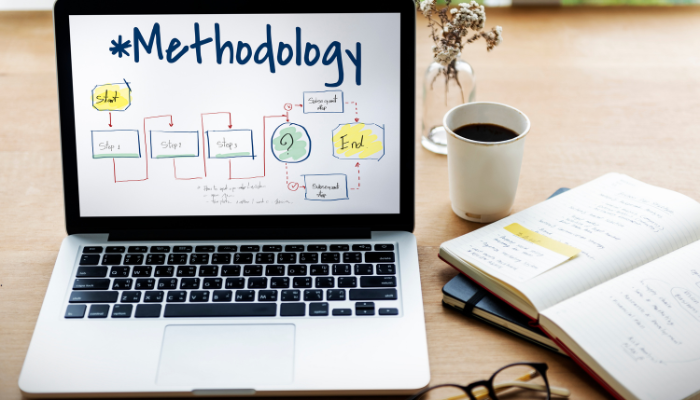“Design is intelligence made visible.”
– Alina Wheeler
This quote perfectly captures the essence of design thinking, where the focus isn’t just on making things look pretty, but on creating smart solutions that people love.
Think about it: Have you ever used a product that just felt right? That’s the power of design thinking. It’s about understanding what people need and finding clever ways to solve their problems.
A study by McKinsey shows that companies who use design thinking make 32% more money than those who don’t. That’s a big deal! It proves that putting the user first really pays off.
In this blog, we’ll discuss how the design thinking ideology can help you create amazing products. We’ll cover key aspects to keep in mind, share real-world examples, and provide tips to get you started.
So, let’s get creative and see how design thinking can make a difference in your world!
Insight and Innovation: The Heartbeat of Design Thinking
Have you ever wondered how groundbreaking ideas come to life? It’s not just about creativity; it’s about insight and innovation.
Insight refers to a deep understanding of a particular issue or problem. It’s more than just information; it’s a realization, a revelation that sparks new ideas and perspectives. Insights can come from a variety of sources, including research, observation, and empathy.
Innovation is the process of creating something new or different that adds value. It can be a product, a service, or a process. Innovation is often driven by insights, as a deeper understanding of a problem can lead to novel solutions.
Human-Centered Design: The Core of Insight and Innovation
At the heart of design thinking lies a profound understanding of human needs. Human-centered design is a methodology that places people at the center of the design process.
By empathizing with users through the design thinking ideology, we gain invaluable insights into their challenges, desires, and motivations. This empathy fuels innovation, leading to solutions that truly resonate with people.
Did you know that first impressions are 94% influenced by design? So, make sure your app or product looks good right away!
To achieve this, we must balance three key factors:
- Desirability: Does the solution solve the right problem for the user? A good insight addresses real human needs.
- Feasibility: Can we actually build it? Your innovation must be grounded in realistic, achievable methods.
- Viability: Is this solution sustainable? Will it work in the long term from a business perspective?
When you hit the sweet spot between these three, you’re not just creating something innovative; you’re ensuring it’s something that works for the user, can be built, and will last. This balanced approach is what makes the design thinking ideology so effective.
Also read: Design Thinking Process: A Human-Centric Approach to Problem Identification
Let’s talk about how to generate insights, the fuel that drives innovation.
Generating Insights: The Core of Design Thinking
Design thinking ideology is all about solving problems by focusing on people. At its heart, it emphasizes empathy and observation—two key tools that help uncover insights and lead to creative solutions.
1. Gathering Inspiration by Observing People
Understand Your Customers World: To truly understand users, you need to step into their environment. Spend time observing their behaviors and listening to their stories. This is where real insights emerge.
Spot Patterns in Behavior: By watching closely, you can see patterns that point to unspoken needs or frustrations. For instance, people often struggle with overly complicated smartphone interfaces—something that stands out when you observe them using their devices.
Use Ethnographic Research: Think of it like studying a culture. By watching people in their daily lives, you can understand their motivations and what drives their choices within the design thinking ideology.
2. Using Empathy to Discover Unmet Needs
Put Yourself in Their Shoes: Empathy helps you see the world as your users do. When you understand their feelings and experiences, you get a clearer picture of the challenges they face.
Ask Open-Ended Questions: Get users to share by asking questions like, “What’s the most frustrating part of using this product?” Their answers will give you clues about what they really need.
Listen Actively: When you listen carefully and reflect back what users are saying within the design thinking ideology, it builds trust and opens the door to deeper insights.
By combining careful observation with empathy, you’ll uncover insights that not only solve problems but go beyond users’ expectations.
Now that you understand how insights are generated, let’s see how to spark creative, breakthrough ideas.
Innovative Approaches: Sparking Creative and Breakthrough Ideas
Once you’ve gained insights into your users, it’s time to turn that knowledge into innovative solutions grounded in the design thinking ideology. Here are some simple but effective ways to spark creativity and come up with breakthrough ideas:
1. Ask the Right Questions
Challenge Assumptions: Don’t just ask, “How can we make this better?” Instead, try asking, “What if we started fresh and redesigned this entirely?” This pushes you to think beyond what already exists.
Focus on User Needs: Frame your questions around what users actually want. This helps you stay grounded in solving real problems for your audience.
Encourage Multiple Ideas: Ask questions that get you thinking in many directions. Generating multiple ideas without judgment helps you uncover unexpected and creative solutions.
2. Go Beyond the Obvious
Use Constraints to Your Advantage: Limitations can actually help you think more creatively. When you’re forced to work within boundaries, you often come up with more innovative solutions.
Draw Inspiration from Other Areas: Sometimes, looking at unrelated fields can spark new ideas. For example, using the metaphor of a garden might help you think differently about designing a digital product.
Experiment and Keep Improving: Try out different ideas within the framework of the design thinking ideology and don’t be afraid to fail. The more you experiment and refine, the more likely you’ll discover something truly innovative.
By combining these approaches with your understanding of users, you can create solutions that are not only creative but also truly impactful.
With these creative ideas in hand, it’s time to bring them to life through prototyping and testing.
Prototyping and Testing: Bringing Ideas to Life
Once you’ve generated ideas using the design thinking ideology, the next step is to bring those ideas to life. Prototyping and testing help turn your concepts into something real, while refining them along the way.
Here’s how you can do it:
1. Turn Ideas into Real Prototypes
Bring Your Ideas to Life Quickly: Prototyping lets you take an idea and create something physical or digital from it. Whether it’s a basic sketch or a simple mockup, it helps you see how your idea could work in real life.
Test Early, Test Often: Don’t wait until your prototype is perfect. The sooner you create a version, the sooner you can test it and learn what works—and what doesn’t. This saves time and effort later.
Keep It Simple: Your prototype doesn’t need to be fancy; it should embody the design thinking ideology by clearly showcasing the core idea, allowing you to gather feedback and improve it.
2. Test, Learn, and Improve
Get Real Feedback from Users: Once you have a prototype, share it with real users to see how they interact with it. Their feedback will show you whether your design meets their needs and reveal areas that need tweaking.
Refine and Repeat: Take the feedback you get and make adjustments to your prototype. Design thinking ideology is all about iterating—each version brings you closer to a solution that truly works.
Innovate as You Go: As you refine your prototype within the design thinking ideology, you also refine the innovation. Testing and iterating help you turn good ideas into great solutions.
By prototyping and testing, you’re making sure your ideas are practical and aligned with what users need.
Also read: What is Prototyping in Design Thinking?
Now that you’ve seen how prototyping brings ideas to life, let’s explore how design thinking works across industries.
Design Thinking Across Industries: Universal Applications
Design thinking ideology is a versatile tool that transcends industries. Its human-centered approach and focus on empathy, creativity, and iteration make it relevant for solving problems across different sectors.
Here’s how various industries have applied design thinking to drive innovation:
1. Healthcare
Hospitals and clinics use design thinking to improve patient experiences. For example, Cleveland Clinic implemented a “patient-first” approach to enhance how care is delivered. By rethinking everything from check-in processes to how patients navigate hospitals, they created more efficient and less stressful environments.
2. Education
Schools and universities apply the design thinking ideology to develop new ways of learning. For example, Stanford’s d.school encourages educators to design curriculums that adapt to student needs, fostering engagement and deeper understanding. This approach has led to more personalized and interactive learning environments.
3. Technology
In tech, companies like Google have integrated design thinking into product development. Their “Design Sprint” methodology helps teams quickly prototype and test ideas, leading to innovations like Gmail and Google Maps, both developed through rapid prototyping and feedback from real users.
4. Retail
Retailers use the design thinking ideology to enhance customer experiences both online and in stores. IKEA, for instance, focuses on customer feedback and continuous testing to improve their products and shopping experience, leading to innovations like their mobile app, which simplifies the furniture buying process.
5. Financial Services
Financial institutions like Capital One leverage design thinking to create user-friendly banking solutions. Through workshops and prototyping, they’ve introduced tools that simplify online banking, making financial management more accessible to customers of all tech-savviness levels.
With design thinking successfully applied across industries, let’s explore how it can enhance innovation within organizations.
Enhancing Organizational Innovation Through Design Thinking
Using the design thinking ideology can greatly boost innovation in your organization. This approach helps reduce risks and creates a culture where collaboration and learning thrive.
Here’s how you can harness this method to drive innovation:
Reducing Risks and Fostering Faster Learning
Prototyping and Testing: Design thinking encourages you to quickly create prototypes and test them in real situations. This lets you get immediate feedback and learn quickly without pouring too many resources into an idea. Think of it as a way to experiment, allowing you to adjust your approach based on what works and what doesn’t.
Fail Fast, Learn Faster: The design thinking ideology teaches that failure is just a step toward success. By viewing mistakes as learning opportunities, you create a safe space for experimentation. This mindset allows for quicker changes and solutions that truly meet user needs.
Cultivating a Culture of Collaboration and Innovation
Cross-Disciplinary Teams: The design thinking ideology thrives on different perspectives. Bringing together team members from various departments can spark creativity and lead to fresh ideas. When people from different backgrounds collaborate, you get a mix of insights that can enhance the innovation process.
Encouraging Open Communication: It’s essential to create an environment where everyone feels comfortable sharing their thoughts. Regular brainstorming sessions and design workshops can keep communication open and inspire team members to tackle problems together.
Empowering Employees: Embrace the design thinking ideology by giving your employees the freedom to take charge of projects and share their ideas. When individuals feel valued and heard, they’re more likely to engage and invest in the innovation process.
Now that you understand how design thinking drives organizational innovation, let’s see how you can get started.
Getting Started with Design Thinking
Ready to dive into the design thinking ideology? Implementing this approach in your organization can lead to innovative solutions that genuinely meet user needs.
Here’s how to get started effectively:
Practical Steps to Implement Design Thinking for Innovation
Define the Problem: Start by clearly identifying the problem you want to solve. Talk to your users through surveys or informal chats. Understanding their perspectives will help you pinpoint the real challenges they face.
Ideation Sessions: Gather your team for brainstorming sessions. Encourage everyone to share their ideas without holding back. You’ll be surprised at how different viewpoints can spark innovative solutions and strengthen the design thinking ideology.
Prototyping: Create simple prototypes of your ideas. These can be sketches, models, or even digital mockups. The goal is to visualize your concepts so you can gather feedback early on, which is a key aspect of the design thinking ideology.
User Testing: Test your prototypes with real users. This step is essential for validating your ideas and ensuring they work for the people you’re designing for. Listening to user feedback will guide you toward the best solutions.
Building a Toolkit with Courses, Empathy Mapping, and Other Resources
Online Courses: Look for online courses that focus on design thinking. Platforms like Coursera and LinkedIn Learning have great options for different skill levels. These courses will give your team the tools they need to embrace the design thinking ideology effectively.
Empathy Mapping: Use empathy maps to explore user emotions, needs, and motivations. This visual tool will help you understand your users better, making sure your solutions are centered around them.
Resource Libraries: Create a collection of design thinking resources, like books, articles, and case studies. Encourage your team to dive into these materials regularly to deepen their understanding of the design thinking ideology.
Networking: Join design thinking communities and forums. Connecting with others in the field can provide fresh perspectives and boost your team’s creativity.
By following these practical steps and utilizing available resources, you can effectively implement the design thinking ideology in your organization. Remember, the heart of design thinking is putting your users first.
Also read: Best Online Tools for Design Thinking Stages in 2024
How Can Codewave Help You Unleash Design Thinking Innovation?
At Codewave, a design thinking led digital innovation company we’re passionate about design thinking. We believe it’s a powerful tool that can unlock innovation and growth across a wide range of industries. We’re not just talking the talk, we’re walking the walk.
Our vision? To make the design thinking ideology accessible and empower everyone to tap into their creative problem-solving potential. We believe design thinking shouldn’t be a privilege for a select few, but a core part of everyone’s work.
But fostering creativity starts with fostering a great work environment. That’s why we’ve built a space specifically designed to spark human greatness. We’re a team that thrives on reimagining the future of your business, using the magic of design thinking and cutting-edge technology.
Here’s what truly excites us: helping your brand connect with people on a deeper, more human level.
We Cater to Diverse Industries:
Think design thinking can’t be applied to your field? Think again! We’ve helped businesses across a wide range of sectors achieve amazing results through design thinking.
Here are just a few examples:
- Education (EdTech): We can help personalize learning experiences and make education more engaging for students.
- Agriculture (AgriTech): Design thinking can help optimize farming practices, improve yields, and connect farmers directly with consumers.
- Retail (RetailTech): We can help you create a seamless omnichannel experience for your customers, both online and in-store.
- Tourism and Hospitality (TravelTech): Design thinking can help you personalize travel experiences and make them truly unforgettable.
- Financial Services (BFSI): We can help you develop innovative financial products and services that meet the evolving needs of your customers.
Our Design Thinking Services:
We offer a comprehensive suite of design thinking services to help you transform your business. Here’s a glimpse into what we can do for you:
- Design Thinking: We can guide your team through the design thinking process, helping you generate creative solutions to your toughest challenges.
- Customer Journey Redesign: We can help you map out your customer’s journey and identify areas for improvement.
- UI/UX Design: We can create user interfaces that are not only beautiful but also intuitive and user-friendly.
- New Product Development: We can help you bring innovative new products to market, from ideation to launch.
- Branding: We can help you develop a strong brand identity that resonates with your target audience.
See Design Thinking in Action:
Curious to see how design thinking can transform a business? Check out some of our successful projects:
- Titan Sequel: Empowering Women to Rejoin the Workforce: We helped Titan create a user-friendly interface that allows women to easily navigate opportunities, access resources, and track their progress on their journey back into the workforce.
- Winner: Revolutionizing Social Media: We helped Winner develop a social media platform with innovative features like event integration, gamification, and smart content delivery.
- Rapid Website and Landing Page Development for Brainspark: We helped Brainspark quickly launch a website and landing page that effectively showcased their services.
This is just a taste of what we can achieve together. Ready to see how design thinking can transform your business? Visit our portfolio for more inspiring examples: Portfolio.
Let’s wrap up now!
Conclusion
The connection between insight, innovation, and human-centered design is at the heart of creating meaningful solutions. However, 55% of organizations say they lack the time to foster a user-centric culture, which can hold back innovation. The design thinking ideology overcomes this by emphasizing empathy and creativity, enabling you to solve challenges efficiently while staying focused on your users.
Albert Einstein said it best: “A person who never made a mistake never tried anything new.” This perfectly embodies the spirit of design thinking ideology—learning from risks and failures often leads to the most impactful innovations.
At Codewave, we know how powerful the design thinking ideology can be for unlocking your team’s creative potential. If you’re eager to innovate and make an impact, reach out to us today. Together, we can turn your insights into actionable solutions that resonate with your audience and drive your success.
Don’t let your ideas sit on the shelf; let’s bring them to life with design thinking! Also read: A Comprehensive Guide to Design Thinking Services and Solutions
Codewave is a UX first design thinking & digital transformation services company, designing & engineering innovative mobile apps, cloud, & edge solutions.







